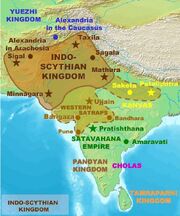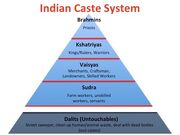
Drift of the continents formed the Himalaya Mountains
50 or 60 million years ago India slowly smashed into Asia and formed the Himalaya and Hindu Kush Mountains that nearly block off India from the surrounding area. Except for the coast, there are only a few narrow passes through the mountains such as the Khyber Pass that have allowed people to enter this land. The other main physical features are the Indus River in modern day Pakistan and the Ganges River in modern day India.

Rock paintings in India, 30,000 years old
"Homonid activity in the Indian sub-continent stretches back over 250,000 years and it is, therefore, one of the oldest inhabited regions on the

planet.
Timeline of the history of ancient India:
c.2800 BC: the Indus Valley civilization begins to emerge
c.1700 BC: the Indus Valley civilization vanishes
c.1500 BC: Aryan tribes begin to infiltrate into northern India from central Asia
c. 800 BC: The use of iron and alphabetic writing begin to spread to northern India from the Middle East
c. 500 BC: two new religions, Buddhism and Jainism, are founded
327 BC: Alexander the Great conquers the Indus Valley
304 BC: king Chandragupta Maurya of Maghada conquers the Indus Valley from Alexander the Great’s successor.
290 BC: Chandragupta’s successor, Bindusara, extends the Mauryan conquests into central India
269 BC: Asoka becomes the Mauryan emperor
251 BC: a mission led by Mahinda, Asoka’s son, introduces Buddhism to the island of Sri Lanka
232 BC: Asoka dies; shortly after, the decline of the Mauryan empire sets in.Source
* * *
Some of the oldest human remains in South Asia date back to around 75,000 years ago. These early humans made tools and lived a nomadic hunter/gatherer life. Artifacts indicate that around 5000 BCE, farming developed in South Asia. Slowly, people began to live in permanent places and villages slowly developed—eventually these villages turned into cities and created one of the earliest human civilizations in the world. This civilization is known by many names: Ancient India, Indus Valley, and Harappan Civilization. Historians and archeologists believe the Indus Valley Civilization began around 3000 BCE. There is evidence of trade between Ancient India and Mesopotamia as early as 3200 BCE.

An Indus seal
One reason the Indus Valley civilization is so mysterious is because historians have not been able to translate their complicated written language called Indus Script. There are thousands of artifacts with 400-600 different written symbols. Most of these symbols were pressed into soft clay with seals.

Migrations in the ancient world, around 4000-1000 BC
Around 1500 BCE, Indo-European people migrated to India. These people came from the area between the Black Sea and the Caspian Sea (purple on the map on the left). Between 4000 and 1000 BCE, Indo-Europeans migrated all over Europe and Asia. Some went to Europe and influenced the Romans and the Greeks; some settled in Turkey and became the Hittites, others migrated southeast instead. Some stopped in Iran, later becoming Persian, while others continued southeast to Pakistan and India. The slow migration did not arrive in northern India until about 1500 BCE. In India, the Indo-Europeans are sometimes called the Aryans.

The spoken language that these Indo-European people brought to India, recorded in Sanskrit, is very similar to other Indo-European languages such as Greek and Latin. There are many examples of similar words between the languages spoken in these areas. Sanskrit was a spoken language that was written down in different writing systems that developed later on such as Devanagari--the early form of Hindi (picture on left), India's main language today.

The caste system formed around 1000 BC, during the "Vedic Age". "This divided Indian society into rigid layers, underpinned by religious rules. Originally there were just four castes, the priestly caste, the warrior caste, the farmers and traders, and the menial workers. Outside the caste system altogether, excluded from Aryan-dominated society, were the “Untouchables”.
"The use of iron spread from the Middle East from around 800 BC, making farming more productive, and populations grew. At first, this occurred on the plains of northern India. However, iron-age farming gradually spread throughout the entire subcontinent. The hunter-gatherers were squeezed more and more into the forests and hills of India, eventually to take up farming themselves and being incorporated into Aryan society as new castes."
In 520 BCE, the Persians invaded and took control of northern Indian subcontinent. This conquest was under the mighty Persian

Alexander the Great
leader Darius the Great. Persia controlled this region for about 200 years until Alexander the Great invaded South Asia. Alexander and his army were far from home and completely exhausted from years of constant war as they rampaged toward the east. It was in India that Alexander’s army finally refused to fight, and Alexander the Great was forced to return to Greece.
The Vedic Age saw the rise of early Hinduism, from which all other Indian religious systems arose.
"Jainism was founded by Mahariva (“The Great Hero”, lived c. 540-468 BC). He emphasised an aspect already present in early Hinduism, non-violence to all living things. He also promoted the renunciation of worldly desires and an ascetic way of life.

Buddhist caves in Ajanta
Buddhism was founded by Gautama Siddharta, the Buddha (“The Enlightened One”, lived c. 565 to 485 BC). He came to believe that extreme asceticism was not a fruitful basis for a spiritual life. However, like Jains, he believed that the release from worldly desires was the way to salvation. In daily life, Buddhists emphasised the importance of ethical behaviour."
Jainism and Budhism developed from Hinduism in the same way Christianity and Islam clearly developed from Judaism. These new religions were a rebellion against cultural ideas such as the caste system and importance of priests in religion.
In the centuries after coming into northern India, the Aryans developed a great abundance of poems, tales, hymns, spells and so on, in an oral tradition known as the Vedas. They were written down long after the “Vedic age”. Another body of literature that was composed towards the end of the Vedic age were the Upanishads, a collection of works of prose and poetry which explore deep religious and philosophical concepts, including the idea that the material world is an illusion, and the implications of this idea for the individual soul.
Later in ancient India’s history, religious and other ideas came to be expressed in short texts called sutras. The earliest Jain and Buddhist scriptures were in this form, setting out the sayings of their founders in a brief, pithy way. Alongside these arose a tradition of elaborate epic poetry. The most famous examples are the Ramayana and the Mahabharata.
As well as religious writings, ancient India produced works on mathematics, medicine, and politics. The Arthashastra of the famous statesman Kautilya anticipates Machiavelli by almost 2,000 years.
All these works were written in Sanskrit, the ancient language of the Aryans. This is an Indo-European language distantly related to Persian, Greek, Latin, German and other tongues. The Sanskrit script was based on the Aramaic alphabet, which came to India from the Middle East some time before 500 BC. One of the greatest linguists in world history flourished sometime in the following centuries. This was Panini. He set out highly logical rules of grammar, which formed the basis of classical Sanskrit. His underlying idea was that words should express meaning as efficiently as possible.
The earliest temples were built in caves.

Buddhist Stupa
Buddhist architecture has become India's most famous architecture.

Buddhist pagoda
The first development is called a stupa. A stupa (below, left picture) is a mound-like structure that contains the ashes and relics of a loved Buddhist leader. Later, the stupa transformed into a new Buddhist structure called a pagoda. A Pagoda (below, right picture) usually has many levels or "tiers" of roofs. It is also a Buddhist temple. Today Buddhist pagodas can be found all over China, Japan and Southeast Asia.
In mathematics, the scholars of ancient India clearly understood the Pythagorean theorem, that the square of the hypotenuse (the side opposite the right angle) is equal to the sum of the squares of the other two sides. The religious texts of the Vedic period contain examples of simple Pythagorean triples, such as, “The rope stretched along the length of the diagonal of a rectangle makes an area which the vertical and horizontal sides make together.”
A medical treatise called the Sushruta Samhita (6th century BC) describes 1120 illnesses, 700 medicinal plants, a detailed study on anatomy, 64 preparations from mineral sources and 57 preparations based on animal sources. Cataract surgery was known to ancient Indian physicians, and was performed with a specially designed curved needle to loosen the lens and push the cataract out of the field of vision.
City planners started by digging water wells and water drainage systems with main roads and small roads laid out in a square grid. Finally homes were built along the roads, sometimes with multiple stories. It appears that most urban homes had water drain systems in the their home--a technology that wouldn't be matched in history for over 3000 years. However, most people didn't live in the urban areas. Most people lived in farming villages in rural areas.

One of the largest structures that has been discovered is called the Great Bath. Basically its a public pool that is over 40 feet long, 20 feet wide, and nearly 10 feet deep. If large temples or palaces once existed they are gone today. This leads to a curious question--did Ancient India have kings or high ranked religious leaders? What did the social pyramid look like? The remains of the civilization suggests they were a very egalitarian society... Another difference is in military and weapons. There is very little evidence of weapons and military culture in the Indus Valley.